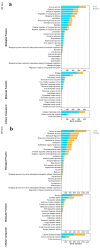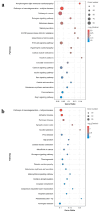New Insights into the Mechanism by Which the Pituitary Gland Copes with Hypoxia Stress Based on a Transcriptomic Analysis of Megalobrama amblycephala
- PMID: 39202348
- PMCID: PMC11353591
- DOI: 10.3390/genes15080987
New Insights into the Mechanism by Which the Pituitary Gland Copes with Hypoxia Stress Based on a Transcriptomic Analysis of Megalobrama amblycephala
Abstract
Hypoxia is a common environmental stressor in aquatic ecosystems, and during the cultivation process, Megalobrama amblycephala is prone to death because it is hypoxia-intolerant, which brings huge economic losses to farmers. The pituitary gland is a crucial endocrine gland in fish, and it is mainly involved in the secretion, storage, and regulation of hormones. In the present study, we compared the transcriptional responses to serious hypoxia in the pituitary gland among hypoxia-sensitive (HS) and hypoxia-tolerant (HT) M. amblycephala and a control group that received a normal oxygen supply (C0). The fish were categorized according to the time required to lose balance during a hypoxia treatment. A total of 129,251,170 raw reads were obtained. After raw sequence filtering, 43,461,745, 42,609,567, and 42,730,282 clean reads were obtained for the HS, HT, and C0 groups, respectively. A transcriptomic comparison revealed 1234 genes that were differentially expressed in C0 vs. HS, while 1646 differentially expressed genes were obtained for C0 vs. HT. In addition, the results for HS vs. HT showed that 367 upregulated and 41 downregulated differentially expressed genes were obtained for a total of 408 differentially expressed genes. A KEGG analysis of C0 vs. HS, C0 vs. HT, and HS vs. HT identified 315, 322, and 219 enriched pathways, respectively. Similar hypoxia-induced transcription patterns suggested that the downregulated DEGs and enriched pathways were related to pathways of neurodegeneration in multiple diseases, pathways in cancer, thermogenesis, microRNAs in cancer, diabetic cardiomyopathy, and renin secretion. However, in the upregulated DEGs, the PI3K-Akt signaling pathway (C0 vs. HS), microRNAs in cancer (C0 vs. HT), and HIF-1 signaling pathway (HS vs. HT) were significantly enriched. There is a lack of clarity regarding the role of the pituitary gland in hypoxic stress. These results not only provide new insights into the mechanism by which pituitary tissue copes with hypoxia stress in M. amblycephala but also offer a basis for breeding M. amblycephala with hypoxia-resistant traits.
Keywords: Megalobrama amblycephala; hypoxia; pituitary; transcriptomic.
Conflict of interest statement
The authors declare no conflicts of interest.
Figures








Similar articles
-
Transcriptome comparison reveals insights into muscle response to hypoxia in blunt snout bream (Megalobrama amblycephala).Gene. 2017 Aug 15;624:6-13. doi: 10.1016/j.gene.2017.04.023. Epub 2017 Apr 18. Gene. 2017. PMID: 28431977
-
The transcriptomic responses of blunt snout bream (Megalobrama amblycephala) to acute hypoxia stress alone, and in combination with bortezomib.BMC Genomics. 2022 Feb 25;23(1):162. doi: 10.1186/s12864-022-08399-7. BMC Genomics. 2022. PMID: 35216548 Free PMC article.
-
Regulation mechanism of oxidative status, immunity and apoptosis induced by hypoxia and heat exposure via PI3K/Akt signaling pathway in Megalobrama amblycephala.Fish Shellfish Immunol. 2024 Dec;155:110027. doi: 10.1016/j.fsi.2024.110027. Epub 2024 Nov 17. Fish Shellfish Immunol. 2024. PMID: 39551115
-
Characterization of duplicated heme oxygenase-1 genes and their responses to hypoxic stress in blunt snout bream (Megalobrama amblycephala).Fish Physiol Biochem. 2017 Apr;43(2):641-651. doi: 10.1007/s10695-016-0318-z. Epub 2017 Jan 26. Fish Physiol Biochem. 2017. PMID: 28127645
-
Comparative transcriptome analysis of gill tissue response to hypoxia stress in the Chinese mitten crab (Eriocheir sinensis).Comp Biochem Physiol C Toxicol Pharmacol. 2025 Feb;288:110081. doi: 10.1016/j.cbpc.2024.110081. Epub 2024 Nov 19. Comp Biochem Physiol C Toxicol Pharmacol. 2025. PMID: 39566594
References
-
- Xu X.C., Zhang J.H., Bao J.L. Review and Outlook on the Development of Megalobrama amblyocephala Industry in China. Fish. Wealth Guide. 2011;15:12–14.
-
- Wang W.M. The current situation of the breeding industry of Megalobrama amblyocephala. Sci. Fish Farming. 2009;4:44–45.
MeSH terms
Substances
Grants and funding
LinkOut - more resources
Full Text Sources

